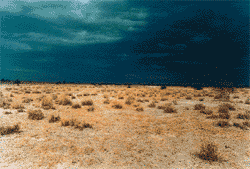Bleak future
 1998 A high-intensity cyclone destroys two oil refineries under construction, six wind farms and a salt production facility in the coastal regions of Gujarat. Later in the year, heavy monsoon flood the entire country.
1998 A high-intensity cyclone destroys two oil refineries under construction, six wind farms and a salt production facility in the coastal regions of Gujarat. Later in the year, heavy monsoon flood the entire country.
1999 The coastal state of Orissa is hit by two successive cyclones, which claim nearly 10,000 lives, and affect 15 million people. The entire coast, which comprises the rice and vegetable belt of the state, suffers large-scale crop loss with damage estimates exceeding us $20 million. An estimated three million homes are leveled by the cyclones, leaving about 7.5 million people homeless.
2000 Over 30 million people in India bear the direct impact of floods. More than 1,500 lives are lost in northeast India alone. Heavy rains and flash floods throw life out of gear and devastate 11 northeastern and eastern states, including Assam, Bihar, West Bengal, and Andhra Pradesh. An estimated 21 million in West Bengal are affected by flooding, as are parts of southern India.
2001 Gujarat experiences heavy rains at the beginning of the monsoon season causing flooding in some districts. The rains are preceded by a severe drought. Orissa is affected once again as unusually heavy monsoon rains inundate about 7,000 villages, affecting a total population of 8.22 million which includes an estimated 2.1 million children. The floods lead to about 1,500 reported cases of diarrhoeal dehydration and outbreak of various water-borne diseases.
Years of consecutive climate-related disasters have brought widespread misery and huge economic loss to India. Is this sheer coincidence, or a fallout of the global climate change? The Indian Meteorological Department (imd) would like to believe that all is well. SK Srivastava, additional director general, imd , opined in an interview in June 2001 that recent weather patterns are caused by "inter-seasonal variables'. Other scientists disagree. According to M Lal from the Centre for Atmospheric Sciences, Indian Institute of Technology, Delhi, "Climate change is already a reality in India, resulting in changes in rainfall and temperature.'
"Even with 0.6
Related Content
- Human rights outlook 2023
- Latin America and the Caribbean: regional overview of food security and nutrition 2021- statistics and trends
- Nigeria: Vaccination Still Eludes 75 Percent of Nigerian Children- Report
- Kenya: Cut On Trump's Fund Puts Millions of Lives At Risk
- 25,000 mines in Rajasthan sans environmental clearances, face gloomy future
- Air pollution scare: Sunday's Real-time Air Quality Index Visual Map in Delhi
